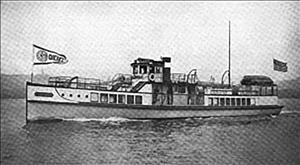On April 23, 1914, the Suquamish is launched in Seattle. Built for the Kitsap County Transportation Company for service on Puget Sound, the Suquamish is the first diesel-powered passenger vessel built in the United States, and the second diesel-powered ship of any kind built on the Pacific Coast, following the launch of the cannery tender Warrior in Seattle two months earlier.
The Vessel, the Town, and the Tribe
The Suquamish was designed by naval architects Lee & Brinton, and was built to carry 180 passengers. Constructed of wood, the vessel was 92 feet long, with a 16-foot beam and a five-foot draft. The vessel was powered by a six-cylinder, 180-horsepower diesel engine built by the New London Ship & Engine Building Company of Groton, Connecticut.
The vessel was built for the Kitsap County Transportation Company at a cost of $26,858.06, for service between Seattle and the town of Suquamish, located on the Port Madison Indian Reservation in Kitsap County. The reservation was established in 1855 on land that had been the Suquamish Tribe's home for centuries.
Chief Seattle's grave was in Suquamish, and Blanche Thompson, his great-great-granddaughter, was chosen to christen the motor vessel Suquamish. The Kitsap County Transportation Company provided free transportation to the launch for more than 100 tribal members living in Suquamish.
A New Era
On April 23, 1914, some 600 people from around Puget Sound came to Seattle to witness the launch at the John Wilson shipyard, located on the East Waterway. At around 3:00 p.m., Warren L. Gazzam (1863-1961), president of the Kitsap County Transportation Company, welcomed them all and introduced the speakers.
Dr. Charles M. Buchanan, superintendent of the Tulalip Indian Agency spoke first, and addressed the crowd in Chinook Jargon, a trade language used between Natives and non-Natives throughout the Pacific Northwest. Buchanan, who later translated his remarks, provided a brief history of Chief Seattle (178?-1866), noting that the tribal leader was born shortly after the Revolutionary War and died a year after the Civil War.
Buchanan told how Chief Seattle saw the arrival of Vancouver's sailing ships when he was just a boy, and lived long enough to see the dawn of the steamship era. Buchanan then celebrated the launch of the diesel-powered Suquamish by shouting out "Chee laly!" -- Chinook for "a new era."
Some History
Noted newspaperman and historian Thomas Prosch (1850-1915) spoke next and read a letter from Seattle pioneer and fellow journalist Samuel L. Crawford (1855-1916), who was unable to attend due to illness. In the letter, Crawford congratulated the Suquamish Tribe for having this historic vessel named for them, and thanked them for being model citizens and good neighbors. Crawford was especially proud that the tribe had erected a flagpole next to Chief Seattle's grave, and flew the American flag atop it.
Prosch also spoke well of the tribe, and praised the Kitsap County Transportation Company for choosing Indian names for their vessels. "We owe much to these Indians, and not the least of that debt is the name of our city," Prosch said, referring to Seattle. "What a blessing it is we has the name Seattle to confer on our great port, instead of having to call it New Liverpool, New Glasgow, New Boston, or New Albany" (The Seattle Times, April 24, 1914).
Next up was real-estate developer Ole Hanson (1874-1940), who had founded the town of Suquamish, and who would later become mayor of Seattle. In his speech, Hanson mentioned that when he first told Warren Gazzam six years earlier that he would be developing a town on tribal land, Gazzam didn't think he could do it, but promised to name a boat after it if he did.
Hanson then praised the recent breaking of "red tape" that allowed "incompetent Indians" to sell off their allotment lands. Hanson said, "They should be allowed to sell their lands, the government to retain the money in trust and pay them the interest. The interest would support them handsomely" (The Seattle Times, April 24, 1914).
Setting Sail
Warren Gazzam thanked all of the speakers, and it was time to launch the vessel. Blanche Thompson broke a champagne bottle against its bow, and the Suquamish slid effortlessly down the ways into the waters of Puget Sound. The Transportation Company filmed the launch, as well the leading participants in the ceremony.
The next few months were spent finishing up work on the vessel. Some of the furnishings -- such as the seats -- were temporary, due to delays at the factories chosen to manufacture them. In June, the diesel engine was installed. The Suquamish began service in July.
The Suquamish operated on Puget Sound until the 1930s, when the Kitsap County Transportation Company was acquired by the Puget Sound Navigation Company. The boat was then sold to the Lake Washington Shipyard, which in turn sold it to Russ Gibson (1899-1979), a yacht broker from Seattle, for conversion into a pleasure craft.

